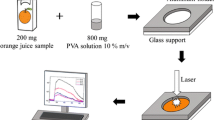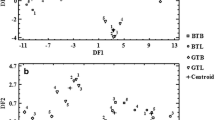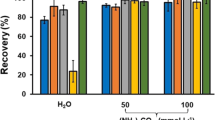Abstract
Microwave-assisted sample digestion and inductively coupled plasma-mass spectrometry (ICP-MS) were considered for exploring major and trace elements in the Mediterranean Sepia ink. The present work aims to (a) fully validate the employed ICP-MS method and compare the Hg determinations by ICP-MS with those obtained by a direct mercury analyzer (DMA) and (b) interpret quantitative data by chemometrics and perform a risk/benefit analysis for assessing the quality/safety of Sepia ink. DMA gave Hg determinations similar to the ICP-MS counterpart (p > 0.05), confirming its reliability for food analysis. Sepia ink demonstrated to be both a reservoir of “healthy” elements and a sink of potential toxic metals. In fact, a good contribution of major and essential trace metals to the established RDAs was revealed, and, at the same time, potentially toxic elements showed to accumulate depending upon the environmental conditions, although not representing a risk for human consumers.



Similar content being viewed by others
References
Ammann AA (2007) Inductively coupled plasma mass spectrometry (ICP MS): a versatile tool. J Mass Spectrom 42(4):419–427
Bua DG, Annuario G, Albergamo A, Cicero N, Dugo G (2016) Assessment of the heavy metal content in aromatic spices by inductively coupled plasma-mass spectrometry. Food Additiv Contam—Part b 1–7
Carvalho ML, Santiago S, Nunes ML (2005) Assessment of the essential element and heavy metal content of edible fish muscle. Anal Bioanal Chem 382(2):426–432
Chandrasekaran M (2012) Valorization of food processing by-products. CRC Press
Commission Regulation (EU) No. 1881/2006 (2006) Setting maximum levels for certain contaminants in foodstuffs. http://eur-lex.europa.eu/legal-content/en/ALL/?uri=CELEX%3A32006R1881. Accessed 26 June 2016
Copat C, Bella F, Castaing M, Fallico R, Sciacca S, Ferrante M (2012) Heavy metals concentrations in fish from Sicily (Mediterranean Sea) and evaluation of possible health risks to consumers. Bull Environ Contamin. Toxicol 88(1):78–83
Costa R, Albergamo A, Piparo M, Zaccone G, Capillo G, Manganaro A, Dugo P, Mondello L (2016) Multidimensional gas chromatographic techniques applied to the analysis of lipids from wild-caught and farmed marine species. Eur J Lipid Sci Technol. doi:10.1002/ejlt.201600043
Derby CD (2014) Cephalopod ink: production, chemistry, functions and applications. Mar drugs 12(5):2700–2730
EFSA CONTAM Panel (EFSA Panel on Contaminants in the Food Chain) (2009) Scientific opinion on the risks to public health related to the presence of arsenic in food. EFSA J 7(10):1351
EFSA CONTAM Panel (EFSA Panel on Contaminants in the Food Chain) (2010) Scientific opinion on lead in food. EFSA J 8(4):1570
Eurachem (1998) The fitness for purpose of analytical methods. A laboratory guide to method validation and related topics. LGC, Teddington, Middlesex, UK
FAO (2015) FAO Major fishing areas. http://www.fao.org/fishery/area/search/en. Accessed 26 June 2016
Hong L, Simon JD (2007) Current understanding of the binding sites, capacity, affinity, and biological significance of metals in melanin. J Phys Chem B 111(28):7938–7947
Institute of Medicine (US). Panel on Micronutrients. (2005) Dietary reference intakes for eergy, carbohydrate, fiber, fat, fatty acids, cholesterol, protein and amino acids. Panel on Macronutrients Panel on the Definition of Dietary Fiber, Subcommittee on Upper Reference Levels of Nutrients, Subcommittee on Interpretation and Uses of Dietary Reference Intakes, and the Standing Committee on the Scientific Evaluation of Dietary Reference Intakes, Food and Nutrition Board. National Academies Press
JEFCA (2011) Evaluation of certain food additives: Mercury. World Health Organization. http://apps.who.int/food-additives-contaminants-jecfa-database/chemical.aspx?chemID=1806. Accessed 26 June 2016
JEFCA (2013) Evaluation of certain food additives: Cadmium. World Health Organization. http://apps.who.int/food-additives-contaminants-jecfa-database/chemical.aspx?chemID=1376. Accessed 26 June 2016
Keller S, Bartolino V, Hidalgo M, Bitetto I, Casciaro L, Cuccu D, et al. (2016) Large-scale spatio-temporal patterns of Mediterranean cephalopod diversity. PloS one 11(1)
Lall SP (2002) The minerals. In: Halver JE., Hardy RW. (Eds.), Fish nutrition. Academic press, pp 259–308
Morgano MA, Rabonato LC, Milani RF, Miyagusku L, Quintaes KD (2014) As, Cd, Cr, Pb and Hg in seafood species used for sashimi and evaluation of dietary exposure. Food Control 36(1):24–29
Nardi EP, Evangelista FS, Tormen L, Saint TD, Curtius AJ, de Souza SS, Barbosa F (2009) The use of inductively coupled plasma mass spectrometry (ICP-MS) for the determination of toxic and essential elements in different types of food samples. Food Chem 112(3):727–732
Özyurt G, Duysak Ö, Akamca E, Tureli C (2006) Seasonal changes of fatty acids of cuttlefish Sepia officinalis (Mollusca: Cephalopoda) in the north eastern Mediterranean Sea. Food Chem 95(3):382–385
Parsons PJ, Barbosa F (2007) Atomic spectrometry and trends in clinical laboratory medicine. Spectrochim Acta Part B At Spectrosc 62(9):992–1003
Salvo A, Cicero N, Vadalà R, Mottese AF, Bua D, Mallamace D, Dugo G (2015) Toxic and essential metals determination in commercial seafood: Paracentrotus lividus by ICP-MS. Nat Prod Res 1–8
Thompson M, Ellison SLR, Fajgelj A, Willetts P, Wood R (2000) Harmonised guidelines for the use of recovery information in analytical measurement, IUPAC, ISO, AOAC International, Eurachem
U.S. EPA (1998) Mercury in solids and solutions by thermal decomposition, amalgamation, and atomic absorption spectrophotometry. U.S. Government Printing Office: Washington, DC, Revision 0
Umar MA, Salihu ZO (2014) Heavy metals content of some spices available within FCT-Abuja, Nigeria. IJAFST, Ottawa 4(1):66–74
WHO (2006) Trace elements in human nutrition and health. http://www.who.int/nutrition/publications/micronutrients/9241561734/en/. Accessed 26 June 2016
WHO (2007) Safety evaluation of certain food additives and contaminants. http://re.indiaenvironmentportal.org.in/files/9789241660594_eng.pdf. Accessed 26 June 2016
Zlatanos S, Laskaridis K, Feist C, Sagredos A (2006) Proximate composition, fatty acid analysis and protein digestibility-corrected amino acid score of three Mediterranean cephalopods. Mol Nutr Food Res 50(10):967–970
Author information
Authors and Affiliations
Corresponding author
Ethics declarations
Conflict of Interest
Giuseppe Daniel Bua declares that he has no conflict of interest. Ambrogina Albergamo declares that she has no conflict of interest. Giovanni Annuario declares that he has no conflict of interest. Vincenzo Zammuto declares that he has no conflict of interest. Rosaria Costa declares that she has no conflict of interest. Giacomo Dugo declares that he has no conflict of interest.
Ethical Approval
This article does not contain any studies with human participants or live animals performed by any of the authors.
Informed Consent
Not applicable.
Rights and permissions
About this article
Cite this article
Bua, G.D., Albergamo, A., Annuario, G. et al. High-Throughput ICP-MS and Chemometrics for Exploring the Major and Trace Element Profile of the Mediterranean Sepia Ink. Food Anal. Methods 10, 1181–1190 (2017). https://doi.org/10.1007/s12161-016-0680-6
Received:
Accepted:
Published:
Issue Date:
DOI: https://doi.org/10.1007/s12161-016-0680-6




